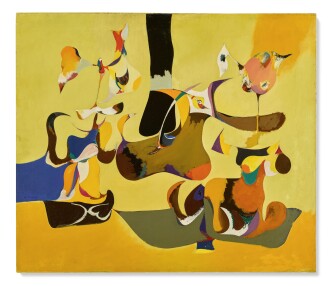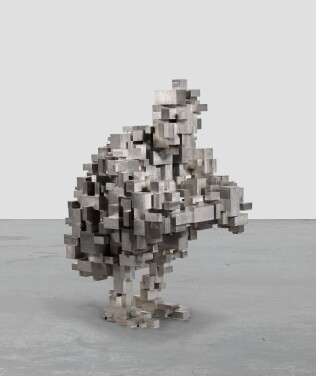S otheby’s major spring Evening Sale will cross categories and geographies, spanning over 500 years, from Old Masters to the 21st century. Entitled Modern Renaissance: A Cross-Category Sale it includes work by key artists from throughout history who have brought about cultural change and renewal; forging new creative paths into the modern world. The sale will be preceded earlier in the day by a live-streamed auction of Impressionist & Modern Art in Paris.
The sale will include works by the foremost pioneers of 20th-century abstraction, such as Wassily Kandinsky, Arshile Gorky, Paul Klee and Wols, while also highlighting masterworks of figurative art, including the monumental Summer Day or Embrace on the Beach (The Linde Frieze) by Edvard Munch. Other highlights include Piero del Pollaiuolo’s arresting Portrait of a Youth, painted circa 1470 and the only portrait by the artist remaining in private hands, provides a striking counterpoint to Edvard Munch’s Self-Portrait with Palette, while Jean Fautrier’s Corps d’otage and Tête d’otage N. 15 depict haunting portraits of hostages at the apex of the Second World War.
Fast-forward several decades to David Hockney who has challenged the very nature of painting throughout his career, often turning convention on its head. He has experimented with photography extensively in his work, and utilised the medium – dissecting the picture plane and presenting multiple facets and versions of the same scene in one composition, almost as the Cubists had. Hockney’s magnificent Tall Dutch Trees After Hobbema (Useful Knowledge) 2017 underscores the strong art historical narrative throughout this cross-category sale via Hockney’s homage to Meindert Hobbema’s celebrated The Avenue at Middelharnis (1689), housed in the collection of the National Gallery, London.
Tour the Exhibition
Auction Highlights

Book a Virtual Private View of the London Spring Sales
This sale season, discover our private virtual viewing service. Available by appointment from wherever you are located, view your favourite works up-close, along with confidential advice and guidance from our specialists.


Quadrat (Square) represents an important period in Kandinsky’s career during which he had begun to explore visual representations of music, rendered with great dynamism and energy. Kandinsky took his cue from the language of musical composition – determined that every colour corresponded with a particular emotion or ‘sound’. For example, mid-green sounded like the quiet, mid-range tones of a violin, whilst yellow-green was perceived to be the higher notes. Painted in 1927, this work perfectly demonstrates Kandinsky’s contribution and influence in the development of painting during the 20th century.
Painted between 1940 and 1941, Arshile Gorky’s Garden in Sochi marks a transformative period in the artists career, as well as being created against the backdrop of the Second World War. The work is rooted firmly in abstraction, but gives a nod to the figurative, through the voluptuous forms of the human figure and its interaction with the organic forms in the garden. Alongside these two works sits Yves Tanguy’s Surrealist landscape La lumière de l’ombre, from 1939. Tanguy was deeply inspired by prehistoric rock formations and objects floating on water in the Bretagne town where he spent his childhood summers.

The sale is led by a number of striking portraits that span 500 years in the history of Western art from Piero del Pollaiuolo’s captivating Portrait of a Youth, an important example of an independent portrait, which was rare for the period, and especially those of children as group portraits and crowd scenes were the favoured mode of representation. This extraordinary work hung as a companion to Botticelli’s Young man Holding a Roundel in the collection of physicist and inventor Thomas Merton. The painting went on to set a record of $92 million earlier this month in New York Masters Week.
The Pollaiuolo is joined by a number of portraits by masters of the genre, including Edvard Munch’s Self-Portrait with Palette, painted in 1926. One of the last remaining self-portraits by the artist in private hands, this captivating work demonstrates Munch’s exploration of the medium and its qualities, and the inclusion of the palette is a deliberate acknowledgement of his role as an artist. The majority of Munch’s self-portraits were not exhibited during his lifetime, they were instead created as deeply personal works of artistic introspection. By contrast to these works, Jean Dubuffet’s La cavalière au diamant (The Dancing Partner with Diamonds), shows the artist’s trademark Art Brut treatment of his subject matter – there are no delicately rendered lines present in this raw and emotive tour de force, instead, Dubffet scores lines into the rough surface of the paint, bringing tension to the encounter between his embracing subjects.

Degas’ Danseuse, Position de quatrième devant sur la jambe gauche, première étude is one of the finest examples of his bronze studies on a subject that captivated him throughout his artistic career, and for which he is best-known. Degas’ ballet dancers offer not only a window into the private world of the dancers, but also a skilful depiction of the human form in motion. Although this a frozen moment in time – filled with a sense of energy and kinetic movement. Joining this sculpture is Frank Dobson’s Female Torso, once in the collection of Alberto Giacometti, and an interesting choice as the two artists’ approach to the human form are in stark contrast to each other. Giacometti’s elongated and slender, and Dobson’s curved, sensual and carved from red sandstone, giving an immediate warmth to the surface of the body. Created in 1926, the year Dobson exhibited in the British Pavilion at the Venice Biennale, this work reinforces him as a key figure of British Modernism.

As a cross-category sale, we are given the opportunity to examine the narrative and thematic threads of art history side-by-side, and form a picture of how artists have drawn inspiration from those that came before them. Whether borrowing stylistically or developing a traditional technique for the modern age, artists have long paid homage to their predecessors. David Hockney’s monumental Tall Dutch Trees After Hobbema (Useful Knowledge) 2017 references the Dutch Master Meindert Hobbema’s celebrated The Avenue at Middelharnis (1689), taking the formal qualities of its composition and adapting them with his trademark brightly-hued application of paint. It is this ability to assimilate certain characteristics from historical paintings that sees Hockney celebrated as a master of the canvas in his own right, as well as a knowledgeable historian – inventively making the composition his own.
Alongside Hockney’s rendition, Edvard Munch’s Summer Day or Embrace on the Beach also draws on art historical references that had long fascinated the artist such as using landscape as a means of exploring the human psyche, as had been by pioneered by the Romantic German painter Caspar David Friedrich. We can see Munch’s interest in photography employed in the structure of this work, namely double exposures creating an ethereal effect through layering translucent images one on top the other. This was a technique often explored in the experimental photography Munch undertook throughout much of his career.


























